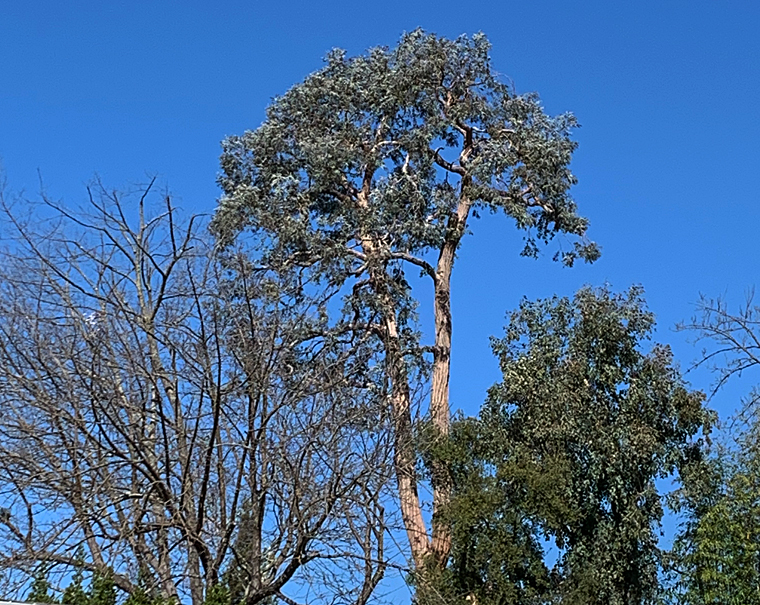
Living things occupy space and declare territory; this is true of plants and animals alike. To the extent possible, a matter of both genes and luck, each living thing extends its sphere of influence. In simple one-celled animals like microscopic paramecium, interaction with its liquid world takes place through minuscule cilia, hairs that move and let paramecium explore and extend their sphere of influence. For trees, the sphere is established through chemicals, roots, leaf canopies and an underground network of fungal mycelium.
My wife and I live amid very large trees with sprawling root systems; each declares its territory by grabbing the lion’s share of sunlight and casting shade on its competition. The largest in the battle is a Red Barked Eucalyptus resinifera (aka Red Mahogany), 110-feet tall. At its base it looks like a 75-year-old Redwood; it’s reddish bark is not like that of the Blue Gum Eucalyptus that constantly sheds, rather, it is well-attached and deeply furrowed all the way up the entire tree trunk and branches. In Australia resinifera reaches 145 feet in height; it is the neighborhood sentinel tree and often the roost for a Red Tailed hawk intent on declaring its own sphere of influence.
Thirty feet southwest, a Pin Oak, Quercus palustris has been vigorously growing two to three feet higher each year, and is now two thirds as tall as the Eucalyptus. Pin Oaks dislike shade, and to escape the sentinel’s dominance it’s growing at a slant at its upper reaches, determined to capture all the sunlight it can.
But the massive Eucalyptus also contends with the presence of an equally aged western Black Walnut, Juglans Californica, which, had its growth not been shaded in its formative years, could have reached a lofty height. As it is, between a combination of self-pruned broken branches and arborist services, it’s a modest sixty feet. The Black Walnut’s sphere of influence comes at the hands of its powerful herbicide, Juglone — produced in its roots, leaves, bark and fruit — which chemically inhibits respiration in many types of plants; in other words, it smothers its competition. Underground, seeking control of water, nutrients and good soil, tree boundaries are an unseen field of battle.

Only the Black Walnut is native to this area, and so well acclimated it’s standard practice for English Walnut to be grafted to the root stock of Black Walnut; you can see the demarcation graft between species by their different bark structure and color, the English Walnuts’ lighter and smoother.
The ancient Celtic ballad entitled Battle of the Trees revealed, according to poet Robert Graves, secrets of Celtic mythology and magic. Today, we modern bystanders observe a more prosaic battle. In spring, the air is misty-yellow with walnut tree pollen that irritates mucus membranes lining the nose and throat; at other times the sweet, honey-like smell of Eucalyptus flowers soothes the senses. In fall, the Black Walnut literally bombs the yard with hundreds of nuts that fall to the ground in a muffled explosion of mushy juglone-filled casings. As it flowers, the Eucalyptus drops thousands of flower caps; one-eighth inch wide and sharply pointed, they make walking barefoot outside painfully inconvenient.
The battle of the trees began long before we moved into our home, and baring misfortune, will most probably continue long after we’re gone. I like that in a tree.